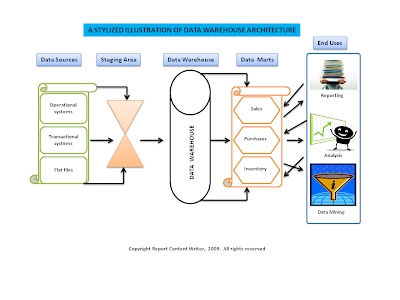A data warehouse is a repository of an organization's electronically stored data, designed to facilitate reporting and analysis.
This definition of the data warehouse focuses on data storage. However, the means to retrieve and analyze data, to extract, transform and load data, and to manage the data dictionary are also considered essential components of a data warehousing system. Many references to data warehousing use this broader context. Thus, an expanded definition for data warehousing includes business intelligence tools, tools to extract, transform and load data into the repository, and tools to manage and retrieve metadata.
Data warehousing arises in an organisation's need for reliable, consolidated, unique and integrated reporting and analysis of its data, at different levels of aggregation.
The process of organizing information in such a way as to create data-based knowledge is called Data Warehousing. The software products that present this knowledge to users are sometimes called Business Intelligence Tools.
The goal of business intelligence and data warehousing - changing data into information and knowledge.
Organizations are gathering and storing more and more data. Every year the amount of data in the world is approximately doubling. This data is of little benefit unless it can be turned into useful information and knowledge.
Information by itself is an inadequate basis for business decisions because the amount of information, like the amount of data, is overwhelming. Business Intelligence Tools are designed to find what is significant - what really adds to our useful knowledge - in the piles of data and information.
Data Mart
Also Known As: Local Data Warehouse or Datamart
A database that has the same characteristics as a data warehouse, but is usually smaller and is focused on the data for one division or one workgroup within an enterprise.
There are three different (and somewhat contradictory) views of the place of the data mart in the world of data warehousing.
1. The data warehouse gathers all the information from the various legacy systems. Specialized data marts are then created with a subset of the information in the data warehouse. These data marts are easier to use because they only have the particular information the specific user group needs. The use of several data marts also allows the querying load to be spread among several different computers. This can reduce network traffic.
2. Free-standing data marts are created, independent from a data warehouse. The information for the data mart probably comes from just one legacy system. It is quicker and cheaper to build a separate data mart instead of building an enterprise-wide data warehouse with data marts derived from it. The drawback of this solution is that the company's data is not integrated (and thereby violates one of Bill Inmon's original defining characteristics of the data warehouse). If several separate data marts are built using this strategy, they will usually contain data that is duplicated and inconsistent.
3. The data mart is the prototype or the first step of a data warehousing process. An enterprise picks the division or group that would most benefit from data-based knowledge. A data mart is built with that group's data. Additional types of information are added to the data mart as time goes on until it is turned into a data warehouse.
New terminology is often created and developed for marketing purposes. The term 'data mart' probably has a marketing advantage over the term 'data warehouse'. The whole data warehousing process is about creating data-based knowledge and bringing that knowledge to people. A warehouse is a place where things are stored away. A mart is a convenient place to buy something. Most data warehousing professionals (including myself) include ready access to information as a defining characteristic of the term 'data warehouse'. I think, though, that the term 'data mart' captures this sense of data availability more effectively.
http://www.sdgcomputing.com/glossary.htm
Subscribe to:
Post Comments (Atom)


Nice post...I look forward to reading more, and getting a more active part in the talks here, whilst picking up some knowledge as well.. Food Grade warehouse Chicago
ReplyDelete